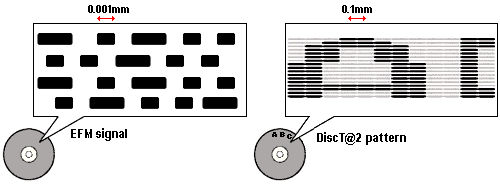After several years in development, it was in the summer of 2002 that Yamaha Electronics introduced its innovative DiscT@2 technology. This allows a CD-RW drive’s laser to tattoo graphics and text onto the unused outer portion of a CD-R disc, thereby providing a far more professional looking disc labelling system than possible by use of stick-on labels or felt-tip markers.
In a normal recording, the recording application will supply a CD recorder with raw digital data, to which the recorder’s hardware adds header and error correction information. This is then converted it to what is known as EFM patterns that represent the data to be written to disc. EFM produces pit and land lengths of between 3 and 11 channel bits. A combination of patterns – from 3T to 11T – is used for writing data to CD-R, with the result that the burned area of a disc is darker in appearance than the unused area.

DiscT@2 takes things a step further, going beyond the limitations imposed by normal EFM patterns. This allows for greater flexibility in the way the laser burns to CD-R, making possible the drawing of visible images.
At the time of its launch, Yamaha recorders featuring this new technology came with a version of Ahead Nero software designed to provide support for the DiscT@2 technology and to allow the tattooing of a disc to be performed immediately after completion of the data or audio recording process. The company’s aim was for all other third-party CD recording software vendors to eventually support DiscT@2 technology through their CD recording applications.
- ISO 9660 Data Format for CDs, CD-ROMs, CD-Rs and CD-RWs
- CD-R – Recordable Compact Disk
- CD Rewritable
- CDR-RW Mini Media
- CDR-RW Digital Audio Media
- CDR-RW Double Density Media
- CDR-RW UDF File System
- CDR-RW Multi-Read Technology
- CD-ROM Burn Proof Technology
- CDR-RW Disc Capabilities
- CDR-RW Over-burning
- CDR-RW Mount Ranier
- CDR-RW DiscT@2 Technology